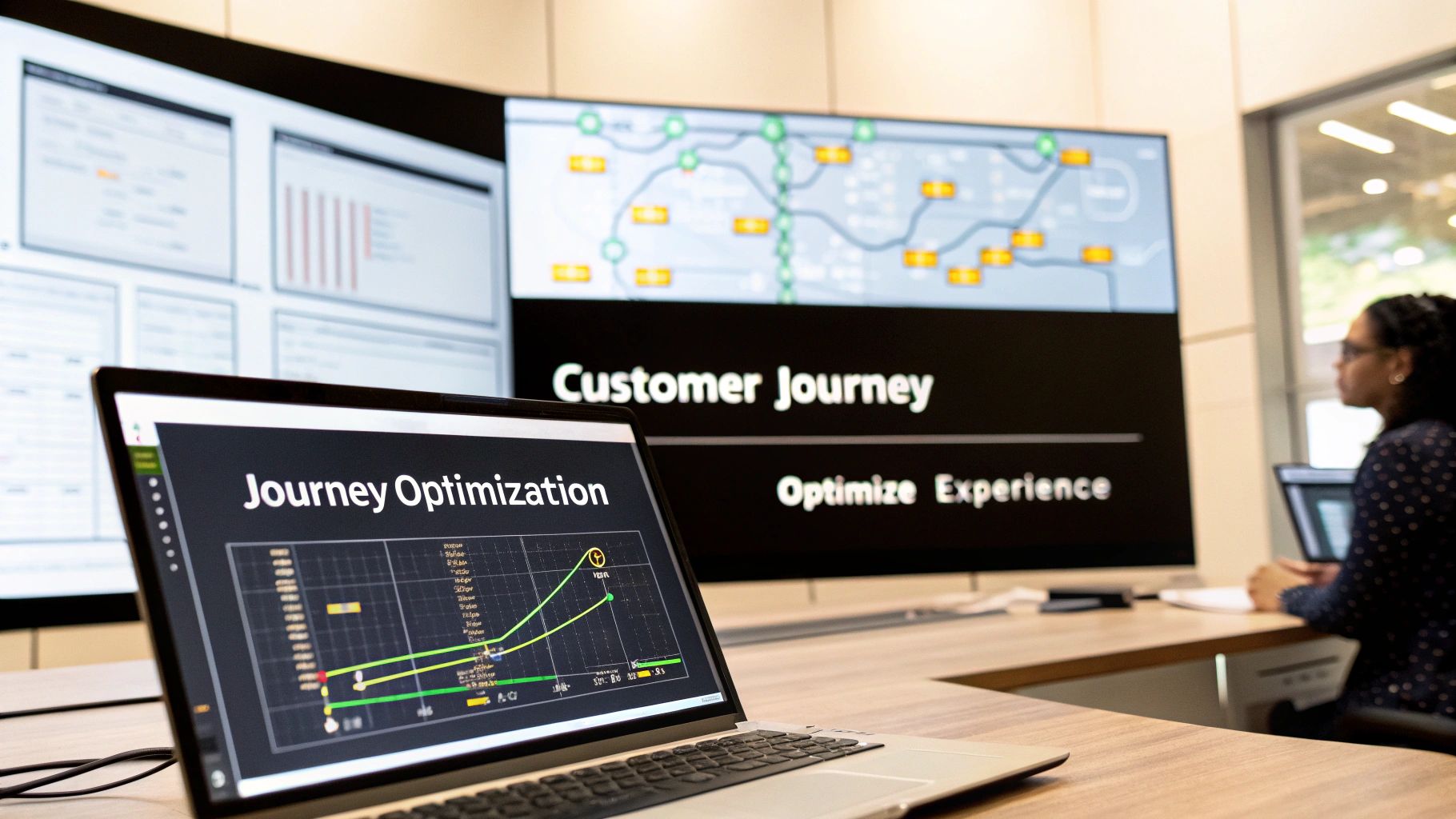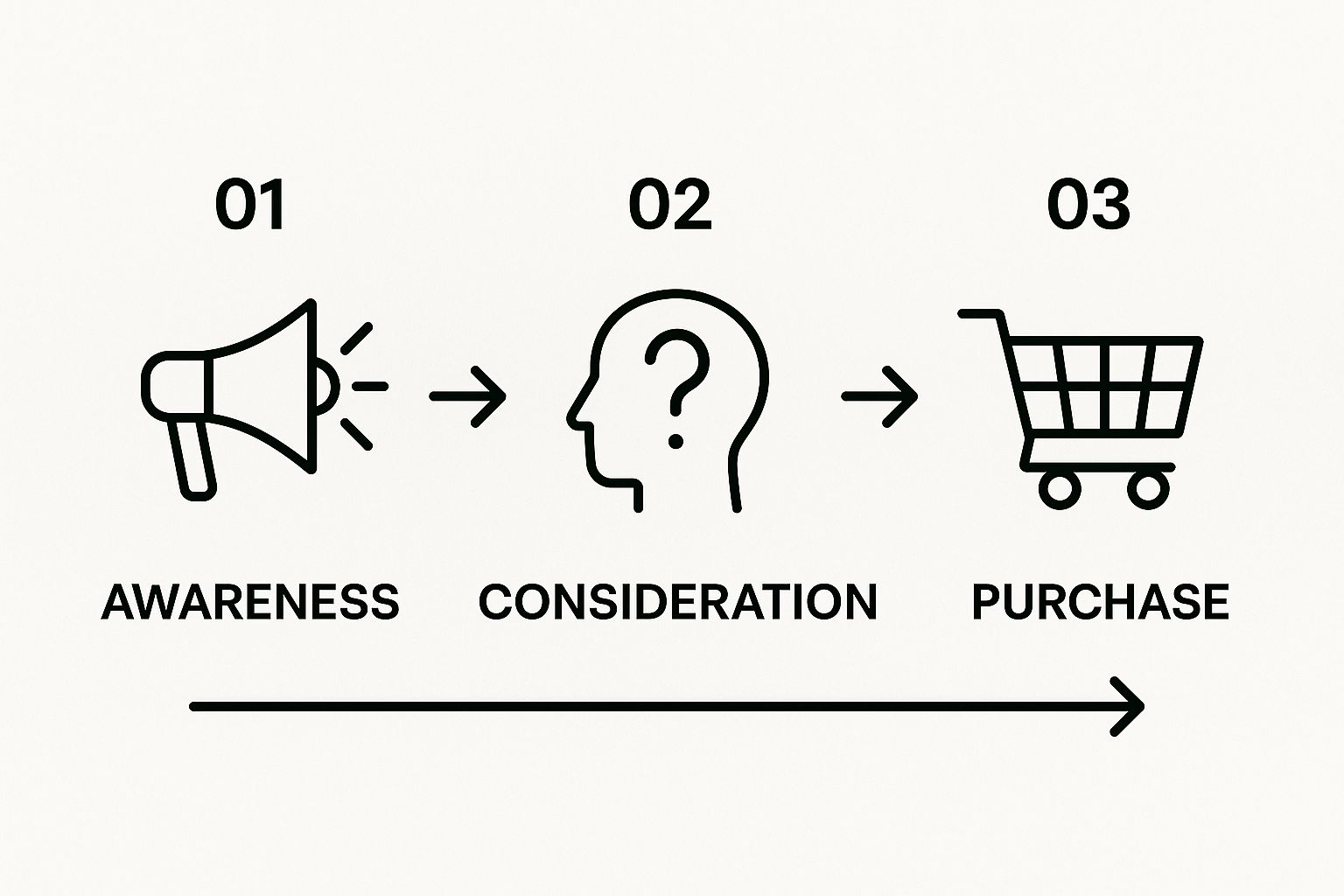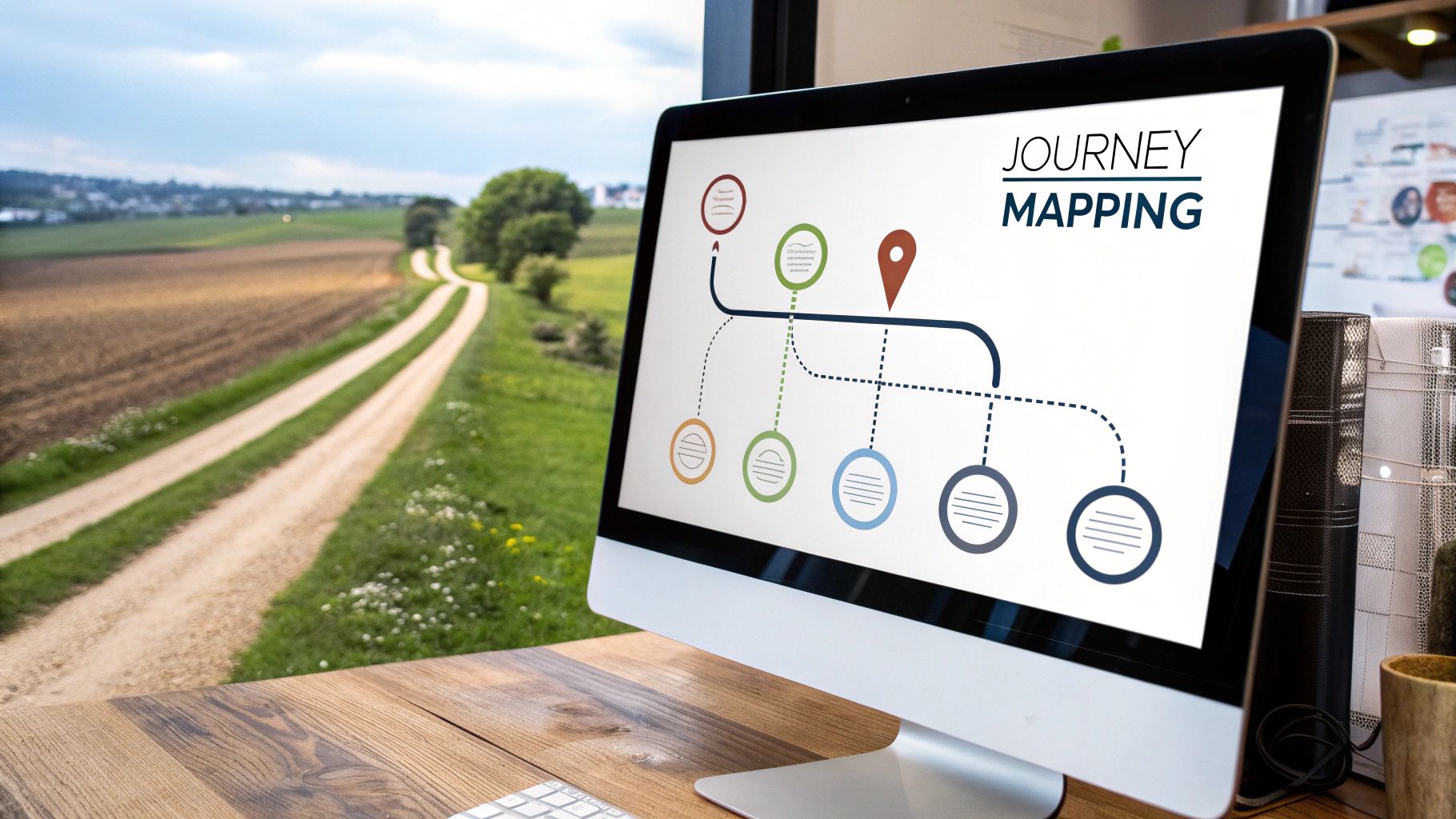Customer Journey Optimization: Key Strategies for Success
May 27, 2025

Understanding What Customer Journey Optimization Really Means
Customer Journey Optimization (CJO) is more than just the latest business buzzword. It's the foundation of successful businesses in today's competitive landscape. CJO isn't about simply fixing broken processes. It's about creating engaging experiences that transform customers into loyal brand advocates. This means understanding the psychology behind customer decisions at every interaction.
Identifying Critical Touchpoints
Successful businesses excel at identifying the crucial moments that influence buying decisions. For instance, imagine a customer navigating your online store. A confusing menu could lead to frustration and them leaving without purchasing anything. However, a personalized product recommendation might encourage them to buy. Every touchpoint, from the initial website visit to post-purchase support, is a chance to improve the customer experience.
Understanding Emotional Drivers
Beyond the practical elements, CJO explores the emotional drivers that impact customer loyalty. Do your customers feel valued? Do they trust your brand? Addressing these emotional needs is just as important as offering a functional product or service. Understanding these emotional touchpoints allows businesses to anticipate and resolve potential problems before they escalate.
Speaking of value, a compelling statistic reveals that 86% of buyers worldwide are willing to pay more for an excellent customer experience. This highlights the immense value customers place on smooth, positive interactions at every stage. Learn more about customer experience statistics. This underscores the importance of prioritizing CJO as a core business strategy.
Recognizing Warning Signs
Effective CJO also means recognizing early warning signs of problems in the customer journey. A sudden rise in cart abandonment rates, negative reviews, or reduced customer engagement can all signal underlying issues. Proactively addressing these issues can prevent customer loss and build lasting relationships. Examining resources like a guide on Shopify benefits can be helpful. By understanding the entire customer lifecycle, businesses can pinpoint areas for improvement and create a more cohesive and rewarding experience.
Creating Journey Maps That Actually Drive Change
Forget complicated flowcharts. Let's talk about customer journey mapping that gives you actionable insights your team can actually use. We'll explore proven methods successful companies use to gather real customer feedback and identify the key moments that truly matter in your customer's experience.
Understanding The Power of Visualization
A well-crafted customer journey map visually represents every touchpoint a customer has with your brand. This covers everything from their initial awareness to post-purchase support and even becoming a brand advocate. This visualization helps you identify pain points and areas ripe for improvement. The following infographic displays these key touchpoints in a simplified customer journey.

This infographic highlights the core stages of awareness, consideration, and purchase. Each stage represents a vital moment where businesses can enhance the customer experience. Understanding these stages allows us to create strategies that meet customer needs and ultimately drive conversions. This leads to the important processes of gathering feedback and implementing effective changes.
Gathering Authentic Customer Feedback
Effective customer journey optimization depends on understanding the customer's perspective. This goes beyond simple surveys. It means actively seeking authentic feedback. For example, conducting in-depth customer interviews can provide valuable information about their motivations, frustrations, and unmet needs.
Analyzing user behavior on your website or app can also reveal pain points in their digital experience. Combining this qualitative and quantitative data helps paint a complete picture of the customer journey.
Identifying Key Moments of Truth
After gathering comprehensive customer feedback, the next step is to pinpoint the moments of truth. These are the interactions that can make or break a customer's relationship with your brand. They have a significant impact on the customer experience.
For example, slow website loading speed during checkout can cause customers to abandon their carts. Identifying these moments is crucial for optimization. Addressing these critical points strengthens customer relationships.
To help visualize different customer journey mapping methods, take a look at the comparison table below:
Customer Journey Mapping Methods Comparison
Comparison of different journey mapping approaches, their complexity, resource requirements, and expected outcomes
| Method | Time Investment | Resources Required | Best For | Expected ROI |
|---|---|---|---|---|
| Basic Surveys | Low | Low | Quick insights, initial understanding | Low – Medium |
| Customer Interviews | Medium – High | Medium | Deep understanding of customer needs | Medium – High |
| Website Analytics | Low – Medium | Low | Identifying digital pain points | Medium |
| A/B Testing | Medium | Medium | Optimizing specific touchpoints | Medium – High |
This table summarizes the different approaches to mapping the customer journey, ranging from quick surveys to more resource-intensive customer interviews. Choosing the right method depends on your specific needs and available resources. While basic surveys offer a quick overview, in-depth interviews provide richer qualitative data. Website analytics, on the other hand, pinpoint digital pain points. A/B testing allows you to test different variations of your website or app to see what works best.
Driving Meaningful Change Through Collaboration
Optimizing the customer journey is a team effort. It requires collaboration across departments and alignment among stakeholders. This means getting everyone on the same page, from marketing and sales to customer service and product development.
Practical collaboration techniques include regular meetings to discuss journey map insights and joint workshops to brainstorm solutions. This collaborative approach ensures that everyone is working towards a shared goal: improving the customer experience. By aligning teams and fostering communication, businesses create a cohesive and positive experience for their customers, ultimately driving measurable improvements and maximizing the impact of customer journey optimization.
Meeting The Speed And Convenience Standards Customers Demand
Today's customers prioritize speed and convenience. They want instant responses and smooth experiences across websites, apps, and social media. This means businesses need to adapt and optimize the customer journey. For Shopify store owners, understanding this is particularly important: How to promote your Shopify store.
The Need For Speed
The digital world demands quick responses. Customers don't have patience for long waits or complicated processes. This has led to a rise in the use of live chat and chatbots, which provide instant support. Adding a chatbot to your website, for instance, can drastically reduce response times and boost customer satisfaction.
Globally, 72% of customers expect immediate service. And 64% of customers will spend more if a business resolves their issues within the same app or website, avoiding the hassle of starting over elsewhere. More on these statistics can be found here. This demonstrates the increasing importance of speed and efficiency.

Seamless Omnichannel Experiences
Customers interact with businesses through many different channels. Creating a seamless omnichannel experience is essential. Regardless of how a customer chooses to interact with your brand, the experience should be consistent. Think of a customer starting an order on their phone and seamlessly finishing it later on their laptop. This is the level of convenience customers expect.
Optimizing For Convenience
Convenience goes hand-in-hand with speed. It's about making things easy for the customer. This might involve a simplified checkout process, diverse payment methods, or personalized recommendations. A streamlined checkout with pre-filled information, for example, can greatly improve conversions. Offering a guest checkout option, removing the need to create an account, is another impactful strategy.
Customer journey mapping is key to understanding and improving the customer experience. For more on this, especially for e-commerce, check out this helpful resource: customer journey mapping. By identifying and addressing pain points, businesses can create more enjoyable and convenient experiences.
Measuring Impact and ROI
Tracking improvements is crucial. Key metrics include customer satisfaction scores, conversion rates, and average order value. Monitoring these metrics helps quantify the return on investment (ROI) from your optimization efforts. This data-driven approach ensures that investments in customer journey optimization are delivering real, measurable results. Continuously analyzing this data allows for ongoing improvements and maximizing the effectiveness of your strategies.
Building Personalization That Customers Actually Notice
Generic experiences are no longer just suboptimal; they're detrimental to business in today's competitive market. This section reveals how successful companies move beyond simply inserting a customer's name to create truly relevant experiences at scale. We'll explore the technologies, data strategies, and organizational shifts needed to deliver meaningful personalization across every touchpoint.
Understanding True Personalization
True personalization goes beyond simply adding a customer's name to an email. It's about understanding individual customer preferences, anticipating their needs, and crafting experiences that truly resonate. This requires a deep dive into customer data and using technology to deliver these experiences efficiently.
Imagine an online clothing store recommending items based on a customer's past browsing and purchase history. This targeted approach is far more effective than showing generic "best sellers."
The Role of Data and Technology
Data is the fuel of personalization. Collecting and analyzing customer data allows you to segment audiences and create personalized messaging, offers, and experiences. AI-driven personalization technologies are vital for scaling this process. Artificial intelligence (AI) analyzes large datasets to identify patterns and predict individual customer needs, making true personalization possible for even large businesses. You might be interested in how to master Shopify social media integration to further leverage your customer data.
Organizational Change: A Collaborative Approach
Successful personalization requires more than just technology; it requires a shift in organizational mindset. Teams must break down silos and work collaboratively to share customer insights and ensure consistent messaging across all channels.
This often involves implementing new processes and training employees to use data-driven insights effectively. This shift ensures that everyone, from marketing and sales to customer service, is working together to deliver a cohesive and personalized experience.
Measuring Personalization Effectiveness
How do you know if your personalization efforts are working? Tracking key metrics is essential. Monitor conversion rates, click-through rates, and customer satisfaction scores to assess the impact of your strategies. A powerful statistic from 2025 highlights that 73% of consumers are likely to switch brands if their interactions feel generic, underscoring the importance of personalization.
AI-driven personalization technologies now allow companies to scale tailored experiences, with some brands seeing conversion boosts of up to 15%. Find more detailed statistics here. Additionally, track qualitative feedback through surveys and customer reviews to gain a deeper understanding of customer perception.

Building Towards Comprehensive Personalization
Start small and focus on one or two key touchpoints. As you gain experience and data, you can expand your personalization efforts across the entire customer journey. This gradual approach allows you to test and refine your strategies, ensuring maximum impact and ROI. Building a culture of data-driven decision-making is essential for long-term success.
Choosing Technology That Actually Improves Your Journey
Customer journey optimization (CJO) is more than just planning the perfect customer experience. It's about using the right technology to bring that experience to life. This means strategically building a technology stack that supports personalization, data analysis, and real-time customer engagement. The right tools can shift CJO from reactive problem-solving to a proactive system of continuous improvement.
Core Technologies for CJO
Several key technologies form the basis of a successful CJO strategy. Customer Data Platforms (CDPs) bring together customer data from different sources, creating a single, complete view of each customer. This unified view is crucial for personalized messaging and targeted offers. Customer Data Platforms are becoming increasingly important for businesses looking to personalize their customer interactions.
AI-powered analytics tools go beyond basic reporting to deliver actionable insights. They can predict customer behavior, identify potential churn, and even suggest personalized recommendations. This allows businesses to anticipate customer needs and proactively address potential issues. Tools like Google Analytics can be particularly valuable in understanding customer behavior. For Shopify merchants, a well-optimized link in bio tool like LinkShop can be instrumental in collecting important customer data and streamlining the buying process. This improves the overall customer experience and increases conversions.
Integrating Technologies for a Seamless Experience
Effective integration of these technologies is essential. A fragmented technology stack creates data silos and hinders personalization. Successful companies prioritize smooth integration between their CDP, analytics tools, marketing automation platforms, and Customer Relationship Management (CRM) systems. This ensures a consistent customer experience across all touchpoints.
Avoiding Expensive Shelf-ware
Just buying technology isn't enough. Many companies invest in expensive tools that become unused "shelf-ware." To avoid this, choose technologies that match your current capabilities and strategic goals. Consider factors like ease of implementation, integration complexity, and the training required for your team. Start with a phased implementation, beginning with a few key technologies and gradually adding more as your team gains experience.
Practical Guidance for Technology Selection
Start by defining your CJO goals. What specific problems are you trying to solve? Which parts of the customer journey need the most attention? Once you understand your needs, research different technology providers. Compare their features, pricing, and integration capabilities.
To help you choose the right technology, the table below outlines the key components of a CJO technology stack.
The following table outlines the key components of a CJO technology stack and helps understand the requirements for effective journey optimization.
Customer Journey Optimization Technology Stack
Essential technology categories, their primary functions, and integration requirements for effective journey optimization
| Technology Type | Primary Function | Integration Complexity | Business Impact | Investment Level |
|---|---|---|---|---|
| CDP | Unify customer data | Medium-High | Improved personalization | Medium-High |
| Analytics Tools | Provide actionable insights | Medium | Data-driven decision making | Low-Medium |
| Marketing Automation | Automate marketing campaigns | Medium | Increased efficiency | Medium |
| CRM | Manage customer interactions | High | Enhanced customer relationships | Medium-High |
This table summarizes the vital elements of a CJO technology stack. The optimal mix of technologies will depend on your particular business needs and objectives. Implementing these tools strategically and thoughtfully is essential for truly enhancing the customer journey. Investing in training and change management is crucial for maximizing your return on investment.
Measuring What Actually Matters For Journey Success

Without the right measurements, customer journey optimization is just guesswork. We need clear metrics and frameworks to track progress and show real business results. It's not enough to simply collect data. We have to use it to make smart decisions that improve profits.
Quantitative Metrics: Tracking the Numbers
Some numbers are essential for measuring journey success. Conversion rates show how well you turn prospects into paying customers. Average order value tells you how much each customer spends per transaction. These metrics give you solid data points for assessing improvement.
Tracking customer lifetime value is also important. This shows the long-term revenue generated by each customer, highlighting the effectiveness of customer retention efforts.
Qualitative Indicators: Understanding the "Why"
Numbers are important, but they only tell part of the story. Qualitative indicators, like customer feedback, provide crucial context. Surveys, interviews, and online reviews can reveal why customers behave in certain ways.
This qualitative data uncovers the emotional drivers behind customer decisions. For example, understanding why customers abandon their carts can lead to targeted improvements in the checkout process.
Establishing Baselines and Setting Targets
Before making changes, establish baseline measurements for your key metrics. This gives you a starting point to measure progress against. Then, set realistic targets for improvement.
These targets should be SMART: Specific, Measurable, Achievable, Relevant, and Time-bound. This structured approach helps keep your optimization efforts focused and effective. You might find this helpful: How to master improve ecommerce sales.
Building Feedback Loops for Continuous Optimization
Customer journey optimization is an ongoing process, not a one-time fix. Build feedback loops into your measurement framework. Regularly collect customer feedback and analyze performance data.
Use these insights to continuously improve the customer journey. Tools like My AI Front Desk can help you continuously optimize the customer journey and adapt to changing customer needs. This iterative approach maximizes the long-term impact of your optimization efforts.
Demonstrating ROI and Building Organizational Commitment
Finally, communicate your progress clearly. Report on key metrics and demonstrate the return on investment (ROI) of your efforts. This builds organizational commitment and secures buy-in for future initiatives.
Highlighting improvements in customer satisfaction and revenue growth shows the value of customer journey optimization as a core business strategy. This data-driven approach ensures resources are used effectively and everyone in the organization understands the importance of the customer experience.
Key Takeaways
Customer journey optimization (CJO) is a continuous process of improvement. By consistently analyzing customer behavior and focusing on key strategies, businesses can create experiences that truly connect. Here are some key takeaways to guide your optimization efforts:
Understanding Your Customer
Truly understanding your customer is crucial. This means creating detailed buyer personas based on real data, not guesswork. Focus on your most loyal customers. What are their demographics, motivations, and pain points? This information will inform every aspect of optimization.
Mapping The Journey
Visualizing the customer journey through journey mapping is essential. Identify all the touchpoints and channels your customers use. For example, a customer might discover your brand through an Instagram ad, browse your website on their phone, and then make a purchase on their laptop. Each interaction is important.
Measuring What Matters
Data-driven decisions are key to success. Track quantitative metrics like conversion rates and average order value. Don't forget about qualitative indicators like customer feedback and online reviews. These offer valuable insights into the why behind customer behavior. Learn more in our article about how to drive traffic to your Shopify store.
Optimizing for Speed and Convenience
Customers expect speed and convenience. 72% of customers expect immediate service. Optimize your website and apps for quick loading times and easy navigation. Simplify the checkout process and offer a variety of payment options.
Personalization: Beyond the Basics
Personalization is more than just using a customer's name. Use data and AI to tailor product recommendations, offers, and messaging to individual preferences. A generic experience can cause customers to switch brands, with 73% of consumers likely to do so.
Choosing The Right Technology
Selecting the right technology is critical for CJO. Customer Data Platforms (CDPs) combine customer data for a complete view. AI-powered analytics tools give actionable insights. Choose tools that meet your business needs and avoid costly, unused software.
Building a Culture of Continuous Improvement
CJO is not a one-time project. Establish clear baselines, set SMART goals, and build feedback loops. Regularly analyze data, gather customer feedback, and adjust your strategies. This ongoing refinement is crucial for long-term success.
Ready to improve your Shopify store's link in bio experience? LinkShop offers a powerful and visually appealing solution to create shoppable pages that improve the customer journey and increase conversions. Visit LinkShop today to learn more and start optimizing your link in bio strategy.



